 Sometimes, it appears that cell phones have become a required accessory attached to every kid and teenager that you see in public. You see them being used for calls, text messaging, music listening, and game playing, virtually everywhere that kids are found. So, how did kids survive without cell phones in the 80′s?
Sometimes, it appears that cell phones have become a required accessory attached to every kid and teenager that you see in public. You see them being used for calls, text messaging, music listening, and game playing, virtually everywhere that kids are found. So, how did kids survive without cell phones in the 80′s?
- Notes in Class. Kids in the 1980s may have been one of the last generations to have to rely on passing notes to communicate with each other during class.
- Pay Phones. Though they are rarely seen in public places today, coin operated pay phones were available on virtually every street corner and in most public buildings. If a kid needed a ride, or otherwise wanted to make a phone call while out and about, it was going to cost them a quarter.
- Home Computers. When personal computers first began to be common in homes, kids were some of the first to begin finding new ways to use them for fun. There were few games available for early home computers, but they were perfect tools for role-playing games such as Dungeons & Dragons, which were extremely popular with the young people of that era.
- Video Game Arcades. In the 1980s, video game arcades became widespread, and functioned as gathering places for kids and teenagers. Games such as Pac-Man and Space Invaders kept kids feeding quarters into the machines.
- Walkman. The Sony Walkman was introduced in 1979, and it changed the way people, especially kids and teenagers, listened to music. By the early 1980s, young people wearing lightweight headphones and bobbing their heads to music had become a common sight in public places. Kids could have their music with them at all times, without annoying people around them.
- MTV. In the early 1980s, MTV debuted, and kids everywhere gathered in front of the television to watch and listen to music videos. MTV literally changed the way the music business operated, as videos became a required part of virtually every new music release.
- Game Consoles. Atari, Sega, and Nintendo became household names in the 1980s, and the first stores devoted completely to electronic game cartridges and accessories began to appear. During this period, many homes began to have at least one television that was devoted completely to video games.
- Game Watches. It may sound a bit hokey to today’s kids, but the introduction of Game Watches by Nelsonic Industries was a huge step in the evolution of gaming. Game watch combined a timepiece with an electronic game, was worn on a wrist like a watch, and could be played anywhere.
- Game and Watch. The Game and Watch from Nintendo was a handheld device that, like the Game Watch above, combined a timepiece and a video game. The early versions were made to play only one game, but later versions allowed the user to play various games on one unit.
- Teen lines. Many homes in the 80′s had more than one phone line for their land line phone. Often times, the second line was referred to as the ‘teen’ line. If they wanted to call their friends, they used the their land line at home to call their friend on their friend’s home phone.
It may be hard for young people today to imagine, but life in the 1980s without cell phones was not only survivable, it was an exciting time of innovation, and many of the applications that kids use on their cell phones today were born during that decade.
Taken From Landline Phone Service

























 Some of the most effective lawyers in the country are women. Being a lawyer demands patience, persistence and the ability to fight for what you believe in, and many women excel in all of these areas and more. As a result, women can earn a lucrative living in the field of law. According to the U.S. Bureau of Labor Statistics (BLS), female lawyers earn a median salary of $78,468 per year. As more and more women earn law degrees, these earnings are likely to increase, and this makes being a lawyer an attractive and lucrative career option for women.
Some of the most effective lawyers in the country are women. Being a lawyer demands patience, persistence and the ability to fight for what you believe in, and many women excel in all of these areas and more. As a result, women can earn a lucrative living in the field of law. According to the U.S. Bureau of Labor Statistics (BLS), female lawyers earn a median salary of $78,468 per year. As more and more women earn law degrees, these earnings are likely to increase, and this makes being a lawyer an attractive and lucrative career option for women. Nearly 78% of healthcare workers are women, and these women tend to make a lucrative living as healthcare professionals. The term healthcare is a broad one, and many different job titles fall under its umbrella, including nurse and physician. As a nurse, a woman can earn an average median salary of $62,450 per year, according to BLS. Physicians can make more than this, and some other fields make substantially less. Overall, healthcare is a stable field with high levels of job satisfaction and employment growth, which makes healthcare a very lucrative industry for women who want to earn more and enjoy what they do.
Nearly 78% of healthcare workers are women, and these women tend to make a lucrative living as healthcare professionals. The term healthcare is a broad one, and many different job titles fall under its umbrella, including nurse and physician. As a nurse, a woman can earn an average median salary of $62,450 per year, according to BLS. Physicians can make more than this, and some other fields make substantially less. Overall, healthcare is a stable field with high levels of job satisfaction and employment growth, which makes healthcare a very lucrative industry for women who want to earn more and enjoy what they do. Women have the potential to make a lot of money as computer and information systems managers. Computer and information systems managers are involved in the management and administration of technology at organizations in order to help companies meet their business goals. According to BLS, women in this position can make median yearly earnings of $65,520. Most computer management and information systems managers are required to have a bachelor’s degree in subjects like business administration management, information technology and management information systems.
Women have the potential to make a lot of money as computer and information systems managers. Computer and information systems managers are involved in the management and administration of technology at organizations in order to help companies meet their business goals. According to BLS, women in this position can make median yearly earnings of $65,520. Most computer management and information systems managers are required to have a bachelor’s degree in subjects like business administration management, information technology and management information systems. A recent study found that women are coming to dominate certain areas of sales, a traditionally lucrative field for those who excel. In fact, the study seemed to show that women tend to have better selling skills than men, translating into substantial earnings for saleswomen. Recent college graduates with a bachelor’s degree can expect to make around $54,000 per year on average, but certain fields, such as pharmaceutical sales, can bring in double or even triple that amount with a few years of experience. It’s no wonder that women are entering the sales workforce in record numbers. Stable job openings and substantial earnings make sales a very lucrative career for women.
A recent study found that women are coming to dominate certain areas of sales, a traditionally lucrative field for those who excel. In fact, the study seemed to show that women tend to have better selling skills than men, translating into substantial earnings for saleswomen. Recent college graduates with a bachelor’s degree can expect to make around $54,000 per year on average, but certain fields, such as pharmaceutical sales, can bring in double or even triple that amount with a few years of experience. It’s no wonder that women are entering the sales workforce in record numbers. Stable job openings and substantial earnings make sales a very lucrative career for women. Many women excel in the field of human resources and have come to earn a very lucrative living as human resource managers. Almost every person will deal with human resources at one point in their working life, and it takes dedication, patience and understanding to truly excel as human resources professionals. BLS lists the median salary for female human resources managers at $59,124, and this number is likely to go up as companies are forced to make difficult hiring decisions in the years to come.
Many women excel in the field of human resources and have come to earn a very lucrative living as human resource managers. Almost every person will deal with human resources at one point in their working life, and it takes dedication, patience and understanding to truly excel as human resources professionals. BLS lists the median salary for female human resources managers at $59,124, and this number is likely to go up as companies are forced to make difficult hiring decisions in the years to come. Not long ago, the field executive managers were almost always male. Much has changed in the past 100 years, and one of those changes includes women taking senior executive management roles, such as the role of CEO or CFO. BLS lists the median salary for female Chief Executives as $83,356, but the highest earners can make up to millions of dollars. These salaries prove that having the right skills and knowledge to manage a large corporation has nothing to do with gender.
Not long ago, the field executive managers were almost always male. Much has changed in the past 100 years, and one of those changes includes women taking senior executive management roles, such as the role of CEO or CFO. BLS lists the median salary for female Chief Executives as $83,356, but the highest earners can make up to millions of dollars. These salaries prove that having the right skills and knowledge to manage a large corporation has nothing to do with gender. Speech-language pathology is an increasingly popular field for women because it provides a high level of job satisfaction, favorable job opportunities and a lucrative salary. According to BLS, women in speech pathology can make a median yearly salary of $58,448, but this number can vary from state to state and depend on the employer. Most speech-language pathologists are required to earn a master’s degree, as well as obtain licensure and certification. The job also requires sensitivity, support, patience and compassion, which may come easy to many women. This exceptionally rewarding job does require a demanding level of schooling, but the pay off of helping patients develop or correct their speech is well worth it.
Speech-language pathology is an increasingly popular field for women because it provides a high level of job satisfaction, favorable job opportunities and a lucrative salary. According to BLS, women in speech pathology can make a median yearly salary of $58,448, but this number can vary from state to state and depend on the employer. Most speech-language pathologists are required to earn a master’s degree, as well as obtain licensure and certification. The job also requires sensitivity, support, patience and compassion, which may come easy to many women. This exceptionally rewarding job does require a demanding level of schooling, but the pay off of helping patients develop or correct their speech is well worth it. Women are increasingly entering the field of pharmacy with lucrative results. According to Forbes, female pharmacists earn a median salary of $85,644. While that median salary is very lucrative, pharmacists must complete a rigorous graduate level program and post-graduate training in order to practice. The job requires exceptional skills in the fields of math and science, as well as a caring and personable demeanor for dealing with customers. Women are proving to exhibit all of these skills, and as a result they are making a lucrative living serving their communities as pharmacists.
Women are increasingly entering the field of pharmacy with lucrative results. According to Forbes, female pharmacists earn a median salary of $85,644. While that median salary is very lucrative, pharmacists must complete a rigorous graduate level program and post-graduate training in order to practice. The job requires exceptional skills in the fields of math and science, as well as a caring and personable demeanor for dealing with customers. Women are proving to exhibit all of these skills, and as a result they are making a lucrative living serving their communities as pharmacists. Computer software engineering has long been a predominantly male career field, but in recent years women have stepped into the industry and have made a good living working as a computer software engineer or computer programmer. According to BLS, computer software engineers can make median yearly earnings of $70,252. Not only is computer software engineering a highly lucrative occupation, but the field is also projected to grow at an exponential rate, resulting in greater job prospects for both women and men. Most computer software engineers earn their bachelor’s degree in computer science or software engineering.
Computer software engineering has long been a predominantly male career field, but in recent years women have stepped into the industry and have made a good living working as a computer software engineer or computer programmer. According to BLS, computer software engineers can make median yearly earnings of $70,252. Not only is computer software engineering a highly lucrative occupation, but the field is also projected to grow at an exponential rate, resulting in greater job prospects for both women and men. Most computer software engineers earn their bachelor’s degree in computer science or software engineering. Women have traditionally dominated the field of education, and this trend shows no signs of slowing down. But while women have traditionally dominated the field of teaching, they are now infiltrating leadership positions within education, such as school counselor and principal positions. These positions are more lucrative than the traditional teaching position. According to BLS, an elementary school principal can make an average salary of $85,905 per year. With salaries like this, it’s likely that women will continue to enjoy the lucrative opportunities a career in education can offer.
Women have traditionally dominated the field of education, and this trend shows no signs of slowing down. But while women have traditionally dominated the field of teaching, they are now infiltrating leadership positions within education, such as school counselor and principal positions. These positions are more lucrative than the traditional teaching position. According to BLS, an elementary school principal can make an average salary of $85,905 per year. With salaries like this, it’s likely that women will continue to enjoy the lucrative opportunities a career in education can offer.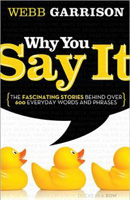 As one can probably ascertain from the title, Why You Say It explores the unusual (if not outright unexpected) origins of various English idioms. Over 600 figurative phrases — some widespread, some rare — come alive through Webb Garrison's fascinating research. History and anthropology buffs, too, have plenty of interesting information to peruse, seeing as how these subjects inextricably tie into linguistics.
As one can probably ascertain from the title, Why You Say It explores the unusual (if not outright unexpected) origins of various English idioms. Over 600 figurative phrases — some widespread, some rare — come alive through Webb Garrison's fascinating research. History and anthropology buffs, too, have plenty of interesting information to peruse, seeing as how these subjects inextricably tie into linguistics.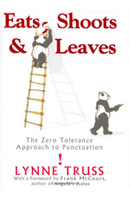 English language enthusiasts mourning its frequent abuse will probably find this book quite the comfort! Here, the author mourns linguistic apathy, particularly when it comes to proper punctuation use, and the myriad ways such mistakes can completely alter a sentence's meaning. Regardless of whether or not they speak the British, Canadian, Oceanic or American dialects, readers can nod sadly along.
English language enthusiasts mourning its frequent abuse will probably find this book quite the comfort! Here, the author mourns linguistic apathy, particularly when it comes to proper punctuation use, and the myriad ways such mistakes can completely alter a sentence's meaning. Regardless of whether or not they speak the British, Canadian, Oceanic or American dialects, readers can nod sadly along.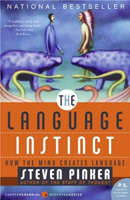 Pick up this MIT professor's lauded work explaining the psychological and cognitive functions that might lurk behind language formation and acquisition. Because scientists and linguists continue arguing over the complex biology of communication, any interested parties should explore the various perspectives. Steven Pinker stands at the forefront of such research, blending different disciplines together into one stimulating package.
Pick up this MIT professor's lauded work explaining the psychological and cognitive functions that might lurk behind language formation and acquisition. Because scientists and linguists continue arguing over the complex biology of communication, any interested parties should explore the various perspectives. Steven Pinker stands at the forefront of such research, blending different disciplines together into one stimulating package. Just like organic matter, languages evolve over time to suit specific needs, and end up on their respective endangered or extinct lists. Here, a journalist explores some of the world's tongues currently (at the time of its 2005 publication, of course) tottering on obscurity and obliteration. But seeing as how that entails a tragically staggering 90% of 6,000 known languages, he can't exactly cover them all.
Just like organic matter, languages evolve over time to suit specific needs, and end up on their respective endangered or extinct lists. Here, a journalist explores some of the world's tongues currently (at the time of its 2005 publication, of course) tottering on obscurity and obliteration. But seeing as how that entails a tragically staggering 90% of 6,000 known languages, he can't exactly cover them all. To put it bluntly, The F-Word dissects the anatomy of an obscenity and chronicles some of its most notorious and notable appearances. An open mind is all it takes to learn more about what goes into establishing and using a profane word many still deem super harsh. And, of course, how frequent use dulls its initially rough edges until general acceptance settles.
To put it bluntly, The F-Word dissects the anatomy of an obscenity and chronicles some of its most notorious and notable appearances. An open mind is all it takes to learn more about what goes into establishing and using a profane word many still deem super harsh. And, of course, how frequent use dulls its initially rough edges until general acceptance settles.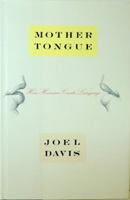 Science, history and linguistics (duh) collide in another highly informative glimpse at how language happens and, of course, evolves. For the most part, however, Joel Davis emphasizes the ways in which these subjects relate back to English. Any speakers wanting to know how it started meandering away from Germanic tongues would do well to check out this incredibly detailed book.
Science, history and linguistics (duh) collide in another highly informative glimpse at how language happens and, of course, evolves. For the most part, however, Joel Davis emphasizes the ways in which these subjects relate back to English. Any speakers wanting to know how it started meandering away from Germanic tongues would do well to check out this incredibly detailed book. And now for something a little different: one of the most classic English language writing guides ever published! With multiple editions available since its 1918 release, "Strunk & White's" allows language lovers to watch how formalized authorship changed over the better part of a century. Obviously, the reference piques its own critics, but that doesn't diminish its influence and importance any.
And now for something a little different: one of the most classic English language writing guides ever published! With multiple editions available since its 1918 release, "Strunk & White's" allows language lovers to watch how formalized authorship changed over the better part of a century. Obviously, the reference piques its own critics, but that doesn't diminish its influence and importance any. Berkeley linguistics professor John McWhorter outlines the five different methods by which language families evolve. Working from the very popular tree model, he explores concepts behind dialects and vernaculars within more mainstream tongues. Despite the author's academic pedigree, content comes relayed in a manner general audiences will probably understand.
Berkeley linguistics professor John McWhorter outlines the five different methods by which language families evolve. Working from the very popular tree model, he explores concepts behind dialects and vernaculars within more mainstream tongues. Despite the author's academic pedigree, content comes relayed in a manner general audiences will probably understand.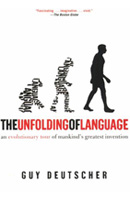 Tracing linguistic changes from the first appearance of humans up to 2006 obviously encompasses considerable head-swirling concepts, but Guy Deutscher delivers! The Unfolding of Language argues that working backwards might unlock mysteries of language structures past. A fascinating perspective even detractors should consider when researching English and more.
Tracing linguistic changes from the first appearance of humans up to 2006 obviously encompasses considerable head-swirling concepts, but Guy Deutscher delivers! The Unfolding of Language argues that working backwards might unlock mysteries of language structures past. A fascinating perspective even detractors should consider when researching English and more. Travel deep inside the Amazon rainforest and learn all about some indigenous peoples and how they communicate. Piraha exists as a nearly autonomous, unique linguistic entity separate from all others, therefore providing a largely undisturbed look at how language and thought interact. And, of course, influence one another, though they seem caught in a perpetual "chicken and egg" scenario.
Travel deep inside the Amazon rainforest and learn all about some indigenous peoples and how they communicate. Piraha exists as a nearly autonomous, unique linguistic entity separate from all others, therefore providing a largely undisturbed look at how language and thought interact. And, of course, influence one another, though they seem caught in a perpetual "chicken and egg" scenario.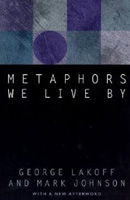 Figurative language can hold just as much sway over how humans perceive the world as its literal counterpart. In fact, metaphorical speech might very well influence cognitive science and development! Though only a theory, the authors certainly create a thoroughly compelling (and now widely accepted) case about the relationship between mind and tongue.
Figurative language can hold just as much sway over how humans perceive the world as its literal counterpart. In fact, metaphorical speech might very well influence cognitive science and development! Though only a theory, the authors certainly create a thoroughly compelling (and now widely accepted) case about the relationship between mind and tongue. Writerly Renaissance man Umberto Eco philosophizes on semiotics, semantics and etymology as only he can. Using humble platypodes and their complete confounding of the biologists what stumbled across them, he explores how description shapes perception. And, of course, eventually goes on to permanently. influence philosophy and other metaphysical subjects.
Writerly Renaissance man Umberto Eco philosophizes on semiotics, semantics and etymology as only he can. Using humble platypodes and their complete confounding of the biologists what stumbled across them, he explores how description shapes perception. And, of course, eventually goes on to permanently. influence philosophy and other metaphysical subjects.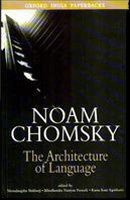 Mainstream audiences tend to think of Noam Chomsky as a sharp political commentator, but scholars know him as the heavily influential MIT linguist. His "generative enterprise" strategy for approaching the subject blended cognitive science with language studies. In The Architecture of Language, Chomsky traces its history, tenets and the way it shape the field forever.
Mainstream audiences tend to think of Noam Chomsky as a sharp political commentator, but scholars know him as the heavily influential MIT linguist. His "generative enterprise" strategy for approaching the subject blended cognitive science with language studies. In The Architecture of Language, Chomsky traces its history, tenets and the way it shape the field forever.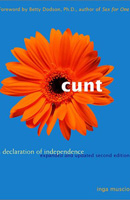 It doesn't take a sociologist to understand why marginalized demographics re-appropriate slurs and shift their nature from offensive to empowering. Initially a positive term, "cunt" eventually transformed into something ugly and insulting, reflecting misogynistic undercurrents present in even allegedly "civilized" cultures. Here, Inga Muscio makes a case for seizing the word back and baptizing it anew as a proud feminist battle cry.
It doesn't take a sociologist to understand why marginalized demographics re-appropriate slurs and shift their nature from offensive to empowering. Initially a positive term, "cunt" eventually transformed into something ugly and insulting, reflecting misogynistic undercurrents present in even allegedly "civilized" cultures. Here, Inga Muscio makes a case for seizing the word back and baptizing it anew as a proud feminist battle cry. Pick up this guide by grammar goddess Mignon Fogarty and avoid malapropism forever, or at least a little while. The Grammar Girl blogger and podcaster outlines English's 101 most common semantic and etymological mistakes. For linguistics buffs interested in how such things come about (PROTIP: usually homophones), this book makes for a fun little read.
Pick up this guide by grammar goddess Mignon Fogarty and avoid malapropism forever, or at least a little while. The Grammar Girl blogger and podcaster outlines English's 101 most common semantic and etymological mistakes. For linguistics buffs interested in how such things come about (PROTIP: usually homophones), this book makes for a fun little read.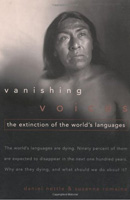 The somber Vanishing Voices welds anthropology and ecology to the study of earth's myriad tongues. Explore how both contribute to the decline and death of different languages, particularly indigenous ones subject to colonialism, imperialism and sprawl. Authors Daniel Nettle and Suzanne Romaine compellingly illustrate how preserving them benefits more than just their speakers.
The somber Vanishing Voices welds anthropology and ecology to the study of earth's myriad tongues. Explore how both contribute to the decline and death of different languages, particularly indigenous ones subject to colonialism, imperialism and sprawl. Authors Daniel Nettle and Suzanne Romaine compellingly illustrate how preserving them benefits more than just their speakers. Grammar defines and refines as much as it confines, and this book discusses why English needs to jettison some of its arbitraries. Doing so, its main thesis argues, will set many writers free and loosen up the language for more casual usage: all provocative thoughts applicable to pretty much any super formalized tongue. Regardless of whether or not one agrees with the idea, it remains something very interesting for language lovers to debate.
Grammar defines and refines as much as it confines, and this book discusses why English needs to jettison some of its arbitraries. Doing so, its main thesis argues, will set many writers free and loosen up the language for more casual usage: all provocative thoughts applicable to pretty much any super formalized tongue. Regardless of whether or not one agrees with the idea, it remains something very interesting for language lovers to debate.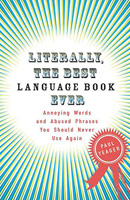 For the more conservative linguistics buff out there, Literally, the Best Language Book Ever distills humor from extremely common grammar and spelling mistakes. At the same time, though, it still educates readers looking for advice on polishing their writing. Even English language fans who think the rules need relaxing might find this perspective intriguing.
For the more conservative linguistics buff out there, Literally, the Best Language Book Ever distills humor from extremely common grammar and spelling mistakes. At the same time, though, it still educates readers looking for advice on polishing their writing. Even English language fans who think the rules need relaxing might find this perspective intriguing. Hegemonies rise and fall for a number of reasons, but language undoubtedly plays an integral role in this social, political and economic phenomenon. Pick up this gripping read and discover how history and linguistics intertwine so intimately they can never truly be torn apart. After all, exploring the past might very well shed some light on where today's most prominent languages might be headed.
Hegemonies rise and fall for a number of reasons, but language undoubtedly plays an integral role in this social, political and economic phenomenon. Pick up this gripping read and discover how history and linguistics intertwine so intimately they can never truly be torn apart. After all, exploring the past might very well shed some light on where today's most prominent languages might be headed. Book reviewers and literary critics analyze language and communication, either for money, love of reading or some combination. Although not explicitly linguistic, Grace Pool's reflections on how poorly many unqualified writers dissect literature undeniably has its place in the field. She proposes some intriguing potential reforms, including a code of ethics and expert reviewers, that might very well change the way periodicals and bloggers look at books.
Book reviewers and literary critics analyze language and communication, either for money, love of reading or some combination. Although not explicitly linguistic, Grace Pool's reflections on how poorly many unqualified writers dissect literature undeniably has its place in the field. She proposes some intriguing potential reforms, including a code of ethics and expert reviewers, that might very well change the way periodicals and bloggers look at books.